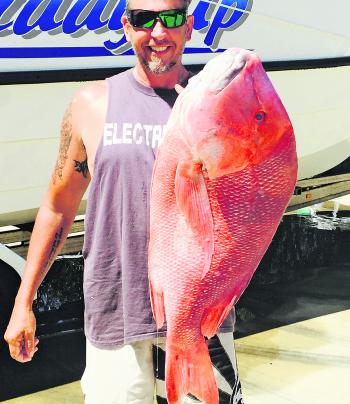I remember writing for Queensland Fishing Monthly in the 90s and never found myself short on inspiration! After arriving in the town of 1770 to manage 1770 Camping Ground in 1989, I was blown away by the huge diversity of fishing areas and the species of fish caught here.
It was not unusual to head for the reef and return over 50% of your catch to the water (yes, we were conservationists back then too). We could afford to pick and choose only the best quality fish for the table, knowing they would still be there for the catching tomorrow. I remember fishing in the Boyne Tannum Fishing Competition and targeting the $600 best sweetlip prize. We put back a few sweetlip in eight hours, to keep one 7.5kg beauty, and some for a feed, all in the process of scoring the top prize. It was that easy!
Well here I am again, 27 years later and now leasing 1770 Camping Ground, which puts me in an ideal position to once again write for QFM. Local knowledge and keen regular campground visiting anglers offer me a wealth of information each month to report.
I know what you’re thinking – what has changed about fishing around 1770 in those years? The answer – not much! Fish are not as plentiful, that’s a fact of life, but fishing has certainly modernised, with new techniques, live bait, state of the art sounders and more importantly GPS. Right, let’s cut to the chase and stop boring you with nostalgia.
Our normal wet season didn’t eventuate, with less than average rainfall, but good rain came four days before Good Friday (thankfully), with 300mm firing up the estuaries. This got the muddies moving in time for Easter with good catches reported, if you were smarter than the crab pot thieves.
Blue and threadfin salmon along with some quality barra were caught from Round Hill Creek and Eurimbula Creek. Live prawns have been the gun bait. Not only the best live bait going, fresh caught prawns will beat any shop bought prawn for sweetness and flavour. Put them in a pot of boiling salt water and pull them out the minute they float and straight into a salt water ice slurry. Yum!
With the persistent and strong southeasterlies of February and March gone, the reef produced some great catches over Easter with an abundance of quality coral trout, red emperor, sweet lip, parrot, hussar and Spanish mackerel. Keith Lecke and crew fished the shelf south of the Bunker Group and scored some huge bar cod, flame snapper, red emperor and other deep water ooglies. There have also been plenty of trevally on the 6-mile Cetacea wreck. You can also catch big grunter at night on squid.
Huge schools of mac tuna have been found all the way from 1770 to the islands and a quick stop to cast into them will set you up with one of the best bottom baits going. Use small metal slugs and a fast retrieve to have lots of fun on light gear. Lighter winds at around 10-15 knots saw over 100 trailers at the boat ramp over the Easter weekend. The best bait to use was live yakka from the bait grounds a couple of kilometres off 1770 Headland. Spotty macs were thick from the catwalk over Easter on 1770 Headland with two local fishers bagging out in two hours after dawn. Blue pilchards did the job.
Well the weather is getting cooler and the light is changing. Winter is coming and that means snapper on the close reefs. May is the start of the inshore snapper season. Fish a floating rig with a whole pilchard or cuttlefish head and snapper should be on the menu. May is traditionally good offshore weather with lighter winds before the big highs in in June. Coral trout, sweetlip, hussar, parrot, and red emperor will be on the close reefs and gutters with red emperor best fished for at night. Live yakkas, squid, pilchard, and mullet are the best baits. Try a whole hussar fillet with the tail on for better fish. Trust me, this is the best trout bait going.
Yellowtail kingfish will move onto the deep-water wrecks Shannon and Barcoola in winter. Knife jigs worked above the wrecks will find fish. Our local creeks will produce some elbow slapping whiting on the run-in tide over the yabby banks. Pump your yabbies on the low tide and find a bank where the tide runs in over the bank into deeper water. Good flathead can also be targeted during the cooler months. Soft plastics on a slow drift should bring one or two aboard around the weed banks outside Toms. Salmon are still around and are partial to a cast and slow retrieve. Use a pink soft plastic at the outlet of a creek drain to find fish. This is where the jelly prawns mass, and while salmon are usually preoccupied with the prawn feast a cast lure into this swirling muddy water will sometimes grab their attention.
For the land-based fisher, longtail tuna and mackerel will be off the Round Hill headland catwalk dawn and dusk as the weather cools down. Mulloway can be caught at night on a hook baited with a bunch of beach worms from the Deepwater National Park Beaches.
If you’re looking for a place to camp with easy access to your boat and a safe mooring you can’t go past 1770 Camping Ground. Absolute beachfront campsites with all amenities included and beachfront campfires are available, if you book ahead. To book phone (07) 4974 9286.
Cheers and tight lines!
Reads: 6330
Gav and Keith with an amazing bar cod.

Keith Lecke with a fine blue Maori cod.

The offshore options are plentiful – check out Neil Moore’s lovely trout

Shaun Bloodworth with a big slab of red.




